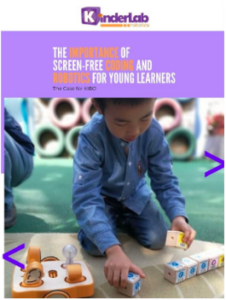EdTech Digest: How Robots Bring a Sense of Play to STEAM Education
Mike Marks, founder and chief roboticist of TSC Robotics, shares his keys to unlocking the creative problem-solver in learners of all ages with coding and robotics, including KIBO. Mike recommends the following steps teachers can take to make the most of their robot-enhanced lessons, especially for early educators looking to incorporate STEAM education:
1) Combine planning and “tinker time.”
2) Choose technology that’s portable, durable, and has a short learning curve.
3) Scaffold your lessons.
4) Use coding robots across multiple disciplines.
Here’s an excerpt from the Ed Tech Digest article:
I’ve seen the magic that comes with letting learning take the form of play. Since 2013, I’ve been holding my introductory robotics workshops in schools and libraries, and young students who have never seen a robot seize the opportunity to take hold of the robot and figure out how it works. In my workshops, the kids aren’t thinking about how robots will introduce them to cross-curricular topics they will eventually excel at in school; they’re ready to play with the robot and the kids around them.
Play for All Ages
My workshops mostly attract young learners, so you’ll imagine my surprise when I was preparing for an evening workshop and six senior citizens walked in, ready to be introduced to robotics. Unlike my young students, their biggest fear was that they were going to break the robot. Once they realized that wasn’t going to happen, they dived right in. A few also wanted to be up to speed about robots for the sake of their grandchildren because they’re always on the lookout for an engaging STEAM gift.
At this particular workshop, I was demonstrating the KIBO robot, an introductory robotics kit designed to inspire kids ages 4–7 to build and program their own robot. To let my senior citizens get a feel for sequencing and coding, I asked them to scan the ’Forward’ programmable wooden building block that makes the robot move forward one step. After they did that, I told them to move the robot forward three steps. It only took them a moment to realize that they already knew what to do, simply scan the block three times in succession.
With young students just starting their path with robotics, I always notice the pride in accomplishment they get from making robots do things like move in a square or to throw a ball into a bucket. It’s the same excitement that comes with coding: seeing a physical result based on a command they gave. It was no different with the senior citizens that participated in my workshop that day. They were playing with the robot by collaborating and then brainstorming ideas about what to program the robot to do next.



















